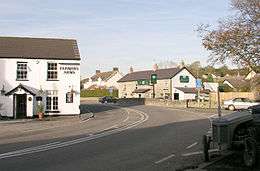Aberthin
Coordinates: 51°28′01″N 3°25′46″W / 51.46704°N 3.42948°W
Aberthin is a small village, just outside Cowbridge in the Vale of Glamorgan, South Wales, on the north side of a shallow valley, less than a mile northeast of Cowbridge across the A48 road.[1] Cowbridge Comprehensive School lies just to the southwest of the village. About 250 metres to the south is an old quarry, with a "faulted strip of grey oolite".[2] Aberthin is also the name of a brook, the River Aberthin.[3] The village was served by the Aberthin Platform railway station between 1905 and 1920, now a field to the west of Aberthin.
Etymology
In English, it is pronounced with emphasis on the second syllable, unlike most Welsh town names which begin with 'Aber'. Many locals pronounce the short 'e' in 'aber' as an elongated 'u'. The village's name is apparently a derivation of the name of the brook, Nant y Berthyn.
Notable landmarks


It has no shops, but does have two pubs, a village hall which when built in 1749 was created as Wales's second purpose-built Calvinistic Methodist meeting house,[4] and a notable tree in the middle of the roundabout. The Methodist church and village was visited in 1746 by Howell Harries and it was at the church where Peter Williams gave a speech in which he was disowned by the Methodists.[5] Houses in the area include Llansannor Court and Great House, Aberthin.[1]
Culture
The village hall committee organises many events throughout the year, such as a duck race (where plastic yellow ducks are raced down the stream), a free bonfire and fireworks display (held on the Downs overlooking the village), quiz nights, amateur dramatics, barn dances, and an annual Village Day, which has a barbecue, live music and a dog show.
References
- 1 2 Royal Commission on Ancient and Historical Monuments in Wales (1981). An Inventory of the Ancient Monuments in Glamorgan: The Iron Age and the Roman. H.M.S.D. Retrieved 19 April 2012.
- ↑ Geological Survey of Great Britain (1927). The Geology of the South Wales Coal-field ...: The country around Bridgend (Sheets 261, 262 of the map), by Aubrey Strahan and T. C. Cantrill, with parts by H. B. Woodward and R. H. Tiddeman. 1904. Printed for H.M. Stationery off., by Wyman and sons, limited. Retrieved 19 April 2012.
- ↑ Willett, Mark (1825). The Stranger in Monmouthsire, and South Wales; or, Illustrative sketches of the history, antiquities, and scenery, of South Wales, and its borders. p. 354. Retrieved 19 April 2012.
- ↑ The Welsh Academy Encyclopaedia of Wales. John Davies, Nigel Jenkins, Menna Baines and Peredur Lynch (2008) pg500 ISBN 978-0-7083-1953-6
- ↑ Davies, D. Elwyn (1982). "They thought for themselves": a brief look at the story of Unitarianism and the liberal tradition in Wales and beyond its borders. Gomer Press. p. 71. Retrieved 19 April 2012.
External links
| Wikimedia Commons has media related to Aberthin. |


